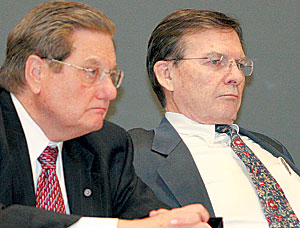 |
|
Jake Lacey/Arizona Daily Wildcat
|
Regent Bob Bulla, left, and President Peter Likins attended the regents meeting in the student union yesterday. NCAA President Myles Brand spoke about the stricter academic regulations soon to be placed on student-athletes.
|
|
|
By Laura Ory and Nick Smith
Arizona Daily Wildcat
Friday, December 2, 2005
Print this
Athletes' grades could affect postseason
Student-athletes will face tough consequences on the playing field next year if they neglect their class work, said NCAA officials.
Myles Brand, NCAA president, described to the Arizona Board of Regents yesterday about the new eligibility requirements of NCAA student-athletes, part of the association's academic reform efforts that began last year.
Under the new rules, teams will be required to achieve a score of 925 on their Academic Progress Rate, a real-time assessment of a team's academic performance, which correlates to an expected team graduation rate of roughly 50 percent, Brand said.
Although student-athletes tend to graduate at higher rates than the general student body and had a 3 percent higher graduation rate last year, Brand said about 80 percent of universities will have one or more teams that fall below an APR score of 925.
If a team falls below an APR score of 925, and a student-athlete leaves the university and is ineligible to return, the team will lose the ability to award one scholarship to a student-athlete for the following year.
The team could potentially lose up to 10 percent of scholarship students on the roster.
For example, the football team, which has 85 students with athletic scholarships, could not lose more than nine slots filled by scholarship athletes, Brand said.
The new requirements should send a message to athletic departments, coaches and student-athletes that student-athletes must make progress toward graduating, Brand said.
Whether student-athletes are on the playing field or in the classroom, Brand said the NCAA expects them to achieve the highest levels they can.
Brand also said universities can expect behavior changes from student-athletes, changes in high school recruitment and more academic success of student-athletes as a result of the reform.
Arizona athletics director Jim Livengood said UA teams are not immune to the new measures.
"At this point, we do have teams in the 80 percent that do have work to do," Livengood said.
He said one concern of the new measures is making sure the data are correct and constant nationwide.
"We're talking about very serious consequences for teams, individuals and universities," Livengood said.
President Peter Likins, who sits on the NCAA committee for fiscal responsibility, said he wants to help the reform effort.
"I better take a good look at my house before I start preaching to other universities," Likins said.
Likins wants to conduct surveys and use focus groups to see where the pressure areas are for student-athletes.
More serious consequences of a team not being up to academic standards include barring a team from competing in the postseason or even decertifying them.
"When you decertify a team, it means no team, men or women's, can play in the postseason," Brand said.
The new standards are not all negatively focused, Brand said.
The NCAA will have about $10 million per year for athletic departments that are improving or are already successful, Brand said.
